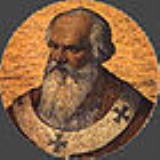
Pope John XVII
Encyclopedia
Pope John XVII born John Sicco, and the son of another John Sicco, was born in the region of Rome
then referred to as Biveretica
. He succeeded Pope Silvester II
(999–1003) as Pope
on May 16, 1003, but died less than six months later.
John XVII was nominated to the papacy by John Crescentius
, a Roman noble who held power in the city in opposition to Emperor Otto III (983–1002). John XVII's successor, Pope John XVIII
(1004–09), was also selected by Crescentius.
John died on November 6, 1003, and was buried in the Lateran Basilica between the two doors of the principal façade. According to John the Deacon, his epitaph began by stating that “here is the tomb of the supreme John, who is said to be Pope, for so he was called.”
hood, Sicco had been married and had three sons who also entered Holy Orders
. They were:
, according to conventional wisdom, and thus his regnal number XVI should have been reused. But this did not occur, and the sequencing has never been corrected.
Rome
Rome is the capital of Italy and the country's largest and most populated city and comune, with over 2.7 million residents in . The city is located in the central-western portion of the Italian Peninsula, on the Tiber River within the Lazio region of Italy.Rome's history spans two and a half...
then referred to as Biveretica
14 regions of Medieval Rome
During the Middle Ages, Rome was divided into a number of administrative regions , usually numbering between twelve and fourteen, which changed over time.-Evolution of the Regions:...
. He succeeded Pope Silvester II
Pope Silvester II
Pope Sylvester II , born Gerbert d'Aurillac, was a prolific scholar, teacher, and Pope. He endorsed and promoted study of Arab/Greco-Roman arithmetic, mathematics, and astronomy, reintroducing to Europe the abacus and armillary sphere, which had been lost to Europe since the end of the Greco-Roman...
(999–1003) as Pope
Pope
The Pope is the Bishop of Rome, a position that makes him the leader of the worldwide Catholic Church . In the Catholic Church, the Pope is regarded as the successor of Saint Peter, the Apostle...
on May 16, 1003, but died less than six months later.
John XVII was nominated to the papacy by John Crescentius
John Crescentius
John Crescentius was the son of Crescentius the Younger. He succeeded to his father's title of consul and patrician of Rome in 1002 and held it to his death....
, a Roman noble who held power in the city in opposition to Emperor Otto III (983–1002). John XVII's successor, Pope John XVIII
Pope John XVIII
Pope John XVIII was Pope in Pisa from 1004 to 1009. He was born Fasanius at Rapagnano, near Ascoli Piceno, the son of a Roman priest named Leo....
(1004–09), was also selected by Crescentius.
John died on November 6, 1003, and was buried in the Lateran Basilica between the two doors of the principal façade. According to John the Deacon, his epitaph began by stating that “here is the tomb of the supreme John, who is said to be Pope, for so he was called.”
Family
Before entering the priestPriest
A priest is a person authorized to perform the sacred rites of a religion, especially as a mediatory agent between humans and deities. They also have the authority or power to administer religious rites; in particular, rites of sacrifice to, and propitiation of, a deity or deities...
hood, Sicco had been married and had three sons who also entered Holy Orders
Holy Orders
The term Holy Orders is used by many Christian churches to refer to ordination or to those individuals ordained for a special role or ministry....
. They were:
- John, BishopBishopA bishop is an ordained or consecrated member of the Christian clergy who is generally entrusted with a position of authority and oversight. Within the Catholic Church, Eastern Orthodox, Oriental Orthodox Churches, in the Assyrian Church of the East, in the Independent Catholic Churches, and in the...
of Praeneste - Peter, a DeaconDeaconDeacon is a ministry in the Christian Church that is generally associated with service of some kind, but which varies among theological and denominational traditions...
- Andrew, a Secundicerius
Confusion over ordinals
The previous legitimate Pope John is generally considered to be John XV (985–996). John XVI (997–998) was an antipopeAntipope
An antipope is a person who opposes a legitimately elected or sitting Pope and makes a significantly accepted competing claim to be the Pope, the Bishop of Rome and leader of the Roman Catholic Church. At times between the 3rd and mid-15th century, antipopes were typically those supported by a...
, according to conventional wisdom, and thus his regnal number XVI should have been reused. But this did not occur, and the sequencing has never been corrected.

